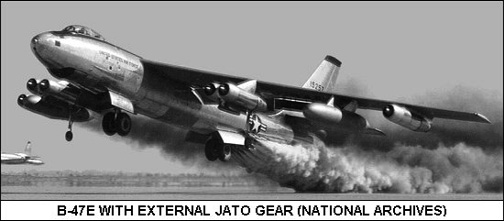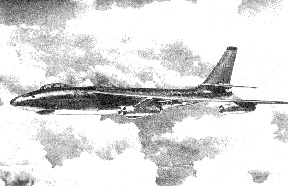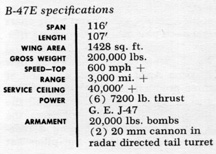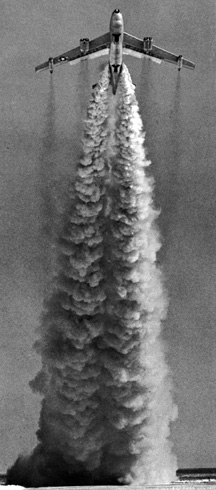|
Relating to The Earl E. Myers Story Attachment to Chapter 23 Page 3 of 3 Pages B & RB-47s IN SERVICE * When B-47s began to be delivered to the Air Force, most crews were excited about getting their hands on the hot new bomber. The thing was so fast that in the early days, the B-47 set records everywhere it flew without even trying. The aircraft handled well and comfortably in flight, with a fighter-like light touch to the controls. The big bubble canopy also enhanced the fighter-like feel of the big aircraft, though it could make the cockpit a "hotbox" on sunny days, while the navigator in the nose froze. However, it took the Air Force until 1953 to turn the B-47 into an operational aircraft. The big aircraft was sluggish on takeoff and too fast on landings, a very unpleasant combination of circumstances. Furthermore, if the pilot put the machine down at the wrong angle on the bicycle landing gear, the aircraft would "porpoise", bouncing fore-and-aft. If he didn't lift off for another go-round, the instability would quickly cause the bomber to skid onto one wing and cartwheel to its destruction. Improved training led to a good safety record, and few crews felt the aircraft was inherently unsafe or too demanding, but apparently there were aircrews who had little affection for or were even afraid of the B-47. Crew workload was also high, with only three crew members to keep the B-47 flying right. The B-52, in contrast, generally had six crewmembers, with much less cramped accommodations. The B-47's reliability and serviceability were also regarded as good. The only major problem was that the electronics systems were not very reliable, unsurprising given the technology available at the time. Much work was done to improve the reliability of the electronics systems, but they remained something of a maintenance headache all through the B-47's operational life. * By 1956 the US Air Force had 28 wings of B-47 bombers and five wings of RB-47 reconnaissance aircraft. The bombers were the first line of America's strategic nuclear deterrent, often operating at forward bases in the UK, Morrocco, Spain, Alaska, and Guam. B-47 bombers were often set up on "one-third" alert, with a third of the operational aircraft available sitting on the runway, loaded with fuel and nuclear weapons, crews on standby, ready to take off on an all-out attack against the USSR at short notice. Crews were also trained to perform "minimum interval take-offs (MITO)", with one bomber following the other into the air at intervals of as little as 15 seconds, to get all the bombers on the way as fast as possible. MITO could be very hazardous, as the bombers left turbulence and, with water-methanol injection, dense black smoke that blinded pilots in the following aircraft. |
|||||||||||
 |
|||||||||||
|
of the B-47 permitted use of Jato assist using an internally mounted arrangement of Jato bottles. Later versions permitted external installation of Jato bottles, slung in jettisonable racks as shown above. Use of Jato was never a major factor in B and RB-47 operations. |
|||||||||||
| Editor’s Note: This text block is not from the Air Vectors Records, but reflects facts published in other sections of this web site. Click over to The Impact of U.S. Aerial Reconnaissance during the Early Cold War (1947-1962): Service & Sacrifice of the Cold Warriors by Frederick J. Ferrer for an in-depth review of these facts.
RB-47 reconnaissance aircraft performed missions in which they penetrated Soviet airspace in numbers. |
|||||||||||
 |
|||||||||||
|
|
|||||||||||
 |
|||||||||||
 |
|||||||||||
|
Photo Ctsy. Boeing Aircraft Co. |
|||||||||||
| The B-47 would be the backbone of SAC into 1959, when the B-52 began to take over and the B-47 wings started to be cut back. Actual B-47 production had ceased in 1957, though modifications and rebuilds continued after that.
* Operational practice for B-47 bomber operations during this time went from high altitude bombing to low altitude strike, which was judged more likely to penetrate Soviet defenses. |
|||||||||||
| Bomber crews were trained in "pop-up" attacks, coming in at low level and then climbing abruptly on nearing the target before releasing a nuclear weapon, and the similar "toss bombing" procedure, in which the aircraft released the weapon while climbing and then rolled away to depart the target area before the bomb fell back down and detonated.
However, stresses due to low altitude operations led to a number of crashes, and an extensive refit program was initiated in 1958 to strengthen the wing mountings. The program was known as "Milk Bottle", named after the big connecting pins that were replaced in the wing roots. * The only B-47s to see anything that resembled combat were the reconnaissance variants. They operated from almost every airfield that gave them access to the USSR, and they often probed Soviet airspace, sometimes stirring up more trouble than they could handle. At least five of these aircraft were fired on, and three of these were shot down. The B-47s fired back with their tail turrets, though it is uncertain if they scored any kills, but it any case these were the only shots fired in anger by any B-47. Final phaseout of B-47 bomber wings began in 1963, and the last bombers were out of service by 1965. The very last USAF operational aircraft was grounded in 1969. The US Navy kept specialized test aircraft in occasional use up to 1976. The final recorded flight of a B-47 was on 17 June 1986, when a B-47E was flown from the Naval Weapons Center at China Lake, California, to Castle AFB, California, to be put in the air museum there. There are at least 15 B-47s that survive on static display, but none are still flying. End of Page 3 of 3 Pages — Use “Back Button” to return to story or Go to EEM Introduction —Chapter 1 — 2 — 3 — 4 — 5 — 6 — 7 — 8 |
|||||||||||